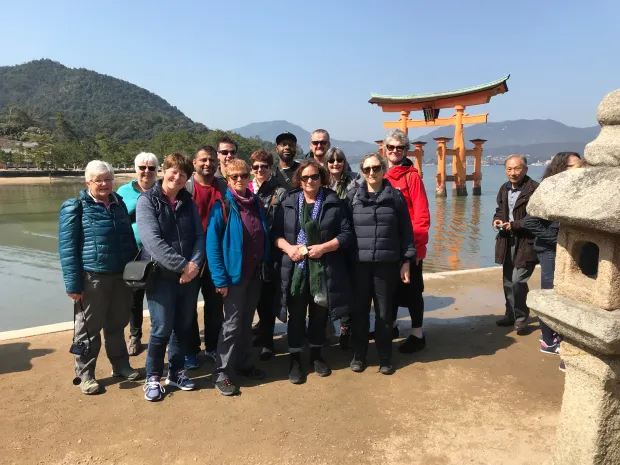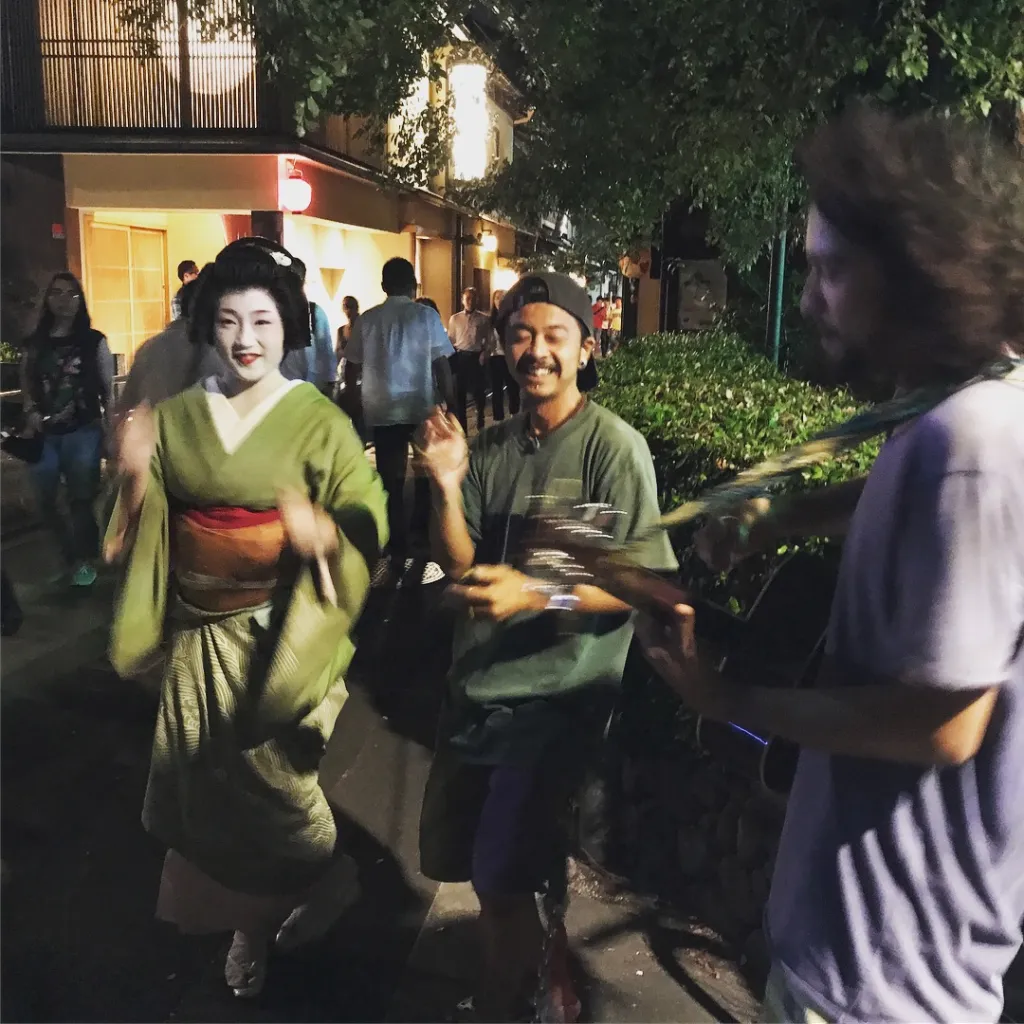The 5 best things to do in Hiroshima
As your dedicated guide and tour designer, You Can Tours Japan will guide you through the experiences, sights, and storied history in Hiroshima.
OR… expand the horizon to wider Japan!
I have led tours throughout regional and metropolitan Japan since 2007.
I also provide travel tips, cultural advice, and some of the best-hidden spots to help you design your own fabulous itinerary for a trip, leaving you with wonderful treasured memories you carry forever.
Checkout my TESTIMONIALS

Below, you’ll find a range of tours I offer within Hiroshima and around the region, or perhaps you’d like something different – I’ve led group and individual tours all over the country; I’d love to create a bespoke tour for you.
We will head straight to Miyajima and enjoy a guided tour of its historical religious and cultural structures then go for lunch.
After greeting you at your hotel or agreed meeting point, we will head straight to the historic island Miyajima.
Join me for a guided tour of two of the region’s perhaps lesser-known but very equally captivating and historic attractions.
Visit Hiroshima Castle before a tour of the fascinating modern history of Hiroshima including the A-Bomb Dome Peace Memorial Park. 5 hours

Well unless your main purpose is hitting the ski slopes, the best periods are March through to May and September through to November, but of course costs rise accordingly. June through August can be very hot and humid (except Hokkaido, which has a relatively climate dry year-round). The rainy season falls usually in July. Every year you will find a “Cherry Blossom Forecast” online to indicate (fairly accurately) what region is blooming over what days (generally you can expect blooms to be 5 – 7 days in duration depending on weather), and likewise Autumn (Sept – Nov) the gorgeous vermillion momiji, and yellow larch and poplar tree colours come out in a similar kind of wave as cherry blossoms up the archipelago.
Japan Rail Pass
Is available as consecutive 7, 14, or 21 days passes beginning on the date the pass can actually be first used. It really is almost indispensable for travel in Japan and valid for all JR train (including bullet train), bus and ferry services throughout Japan either a whole country or regional passes. Simply hop on and hop off! – although planning and making reservations is a recommendation.
You might also Google to order through your most local pass vendor. You purchase a pass (approx 10% cheaper out of country) and receive an Exchange Order voucher which you can validate that at the JR desk at MAJOR Stations and Narita, Haneda Kansai Airports USING THE PASS
IC cards – rechargeable transit fare cards that can be used to conveniently pay fares on public transportation and to make payments at many vending machines, shops and restaurants by simply touching the card on a reader. The most convenient (valid for use throughout the country) are SUICA / PASMO / ICOCA, though even these may not be valid in some cases, albeit rare. It might be prudent to check when boarding. They can also be used for bullet train fares but that requires a particular registration. There are many different brands but others types than the above mentioned, you might come across tend to be limited region/metropolitan use. In my expereince ICOCA is the most user friendly (recharging and range of usability)
IC cards can be purchased at ticket machines and ticket counters at most major railway stations. The initial cost consists of a refundable deposit of ¥500 plus an initial amount (typically ¥1500) to be charged onto the card. The maximum amount to be charged onto a card is ¥20,000.
Japan has an image of being one of the most expensive countries in the world, and if you’re staying in hotels, eating out, and traveling around a lot, it can be.
Accommodation costs really depend on your preferences but choices range from AIrBnB (it’s still a bit new here and pay close attention to the detail), Capsule hotels (even as a one-off adventure!), Manga Cafe, Temple Lodgings,- there is a seemingly vast range of options compared with other countries you might have visited:
Most Obvious
Ryokan
6,000 to 40,000 yen per person
Ryokan are traditional Japanese-style inns with Japanese-style rooms. A stay at a ryokan typically includes dinner and breakfast and is recommended to all travellers to Japan as it gives you the opportunity to experience an often very classy traditional Japanese lifestyle. It is almost invariably on futon rarely with western style beds.
Minshuku
4,000 to 10,000 yen per person
Minshuku are Japanese-style bed and breakfast lodgings. They are usually family run, offer Japanese-style rooms, and often include one or two meals in the price.
Western-Style Hotels
8,000 to 50,000 yen per room
Western-style hotels, including various international and Japanese hotel chains, can be found across Japan, especially in the larger cities.
Business Hotels
6,000 to 12,000 yen per room
Business hotels offer small, simple Western-style rooms with snacks and drinks provided by vending machines. Some business hotel chains, such as Route Inn, APA Hotel, Super Hotel and Toyoko Inn, operate dozens of hotels across Japan.
Pensions
6,000 to 12,000 yen per person
Pensions are comparable to minshuku (see above), except that they offer rooms in Western-style rather than in Japanese-style. They are typically found in mountainous resort towns and in the countryside and in may cases only open seasonally.
Hostels and Dormitories
1,500 to 4,000 yen per person
Hostels offer lodging and meals at the lowest budget level. Japan Youth Hostels, a member of the International Youth Hostel Federation, operates more than 300 hostels across Japan.
Japanese and Western Style
Vacation Rentals
5,000 to 30,000 yen per property
Airbnb and other vacation rental services are popular in Japan. On offer are apartments and rooms with traditional or modern interior, as well as restored historic houses.
Unique Lodgings
Capsule Hotels
3,000 to 4,000 yen per person
Mainly targeting a male clientele in need of nothing but a bed, capsule hotels accommodate their guests in small capsules. A television, a shared bathroom and coin lockers are usually provided. Some proved a spa but you may find it not the most peaceful night’s sleep.
Temple Lodgings
5,000 to 15,000 yen per person
It is possible for tourists to spend the night at some Buddhist temple lodgings (shukubo). A stay often includes two vegetarian meals and the opportunity to join the morning prayers. One of the best places to experience a night at a temple is Mount Koya.
Manga Cafes / Manga Kissaten
1,500 to 3,000 yen per person
Manga cafes are establishments that provide their customers with seats or booth to read manga (Japanese comics) and surf the internet. Many of them are open 24 hours and provide various amenities that make them a novel and surprisingly comfortable option for low-budget overnight stays.
Love Hotels
6,000 to 12,000 yen per room
Not meant as tourist lodgings, love hotels are visited by couples who wish to enjoy some undisturbed time together. Rooms at love hotels can be rented for 2-3 hours during the day or for an overnight stay.
Overnight Buses (Highway Bus)
From around 3,000 yen one way
Overnight buses combine cheap transportation with one night worth of accommodation. Services are available between many cities and are particularly economical along the most popular routes, such as Tokyo-Kyoto/Osaka. Seating ranges from regular bus seats to private compartments.
Surprisingly you can eat well for comparatively little in Japan. Of course You might want to splash out on a high class sushi or tempura meal, or if you stay at a Ryokan or Minshuku you will get a delicious banquet of relative size and variety.
The restaurant chain stores are very cheap, very good quality and very hygiene focused and here below are a few suggestions to get you going! They generally follow the MacDonald model (not like that food production!)
Most sushi train restaurant range from ¥100 – ¥500 approx per plate
Convenience Stores (Seven Eleven / Family Mart / Lawson sell fresh good quality low cost meals. In my opinion Lawson does the best coffee.
Hyakuen Stores(dollar / pound store) like Daiso sell cheap snacks
Vegetarian
Some people erroneously assume that Japanese food has a vegetarian tradition (according to its relationship with Buddhism). Not so. In Tokyo Osaka Nagoya you will not have too much trouble but in the countryside and regional cities your choices are very limited if any at all. But vegetarians or usually accustomed so I recommend planning ahead. For particular locations I can make recommendations if you’d like to contact me.
This is an entirely subjective thing but if you’re a first-time, or even third or fourth time visitor, these places are are well worth spending time at.
I will very happily provide advice on attractions and plans via contact me.
If you’d advice on more off-the-beaten track, or would like an itinerary (self guided / or guided by me), I’d love to share my expertise with you and please contact me.

Following is a series of blogs that I hope will prove useful information for visitors.
Hiroshima City,
Hiroshima Prefecture,
Japan.
youcantours4U@gmail.com
+81 70 2350 3645
You Can Tours Japan © 2022. All Rights Reserved